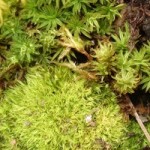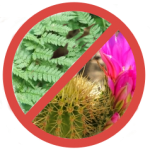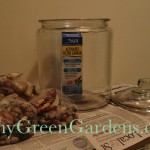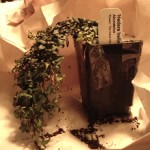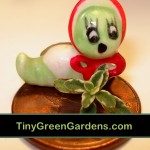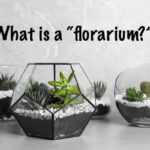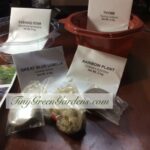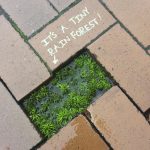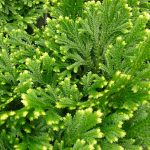5 Common Terrarium Mistakes
You’ve probably seen many of the stunning photos of terrariums on Pinterest, Etsy and just about everywhere else on the web. They show you their oh-so-pretty creations. They make it seem like they are the easiest way to care for plants…ever in the history of man. Sure, done correctly, a closed terrarium can become a self-sustaining ecosystem that requires very little human intervention. But, consider this, you are trying to recreate a natural earth-like environment with everything that the plants living in that environment need to survive. Considering the delicate balance of the Earth you live on, what do you think the chances are of you setting up a terrarium, the first time, correctly?
Few of those glowing testimonials on terrarium building share the mistakes they have made. I’ve shared a few of mine on my How to Build a Terrarium post. The information seemed worthy of its own post. When I talk of terrariums here, I am referring to a glass-enclosed and lidded environment.
Terrarium Mistakes #1 – Choosing the wrong plants.
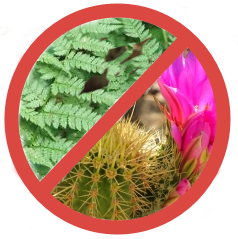 There is so much information being shared about building terrariums. Some of it is excellent. Some of it will lead to expensive piles of goo. Many mention plant selection. However, they don’t always make it clear that closed terrariums are not ideal for every plant, regardless of how it is sold and marketed.
There is so much information being shared about building terrariums. Some of it is excellent. Some of it will lead to expensive piles of goo. Many mention plant selection. However, they don’t always make it clear that closed terrariums are not ideal for every plant, regardless of how it is sold and marketed.
Many of the drool-worthy terrarium photos being posted online, make this mistake. Truth be told, succulents mixed with tropical plants make a lovely display – at least until you over-water or under-water half of the plants.
- Succulents and cacti will never survive living in a closed terrarium. They do not care for humidity or moist environments.
- There are many non-succulent plants that would be unhappy in a terrarium. I learned the hard way that one of the favorites for fairy gardens, creeping thyme, will die in a moist environment.
- Plants that require direct sun and a lot of it will lead to one of three outcomes…
- The sun-loving plant will die if the terrarium is not put in the sunshine.
- If you put the terrarium in the direct sunshine, the closed glass environment will turn into an oven that will cook everything to death.
- If you put the terrarium in the direct sunshine and it is a little on the damp side, you might grow the most wonderful colony of putrid-smelling algae.
- Tillandsias, or air plants, require air flow. A closed terrarium, by it’s nature, will not include any air movement much less provide the air-born organic matter that tillandsias feed upon.
- That cute little plant you buy today, might grow to be several feet tall at maturity. It’s one thing if you buy a plant for an outdoor fairy garden that grows 3-4 times larger than you planned but in a terrarium it may require removing the plant and upsetting your entire ecosystem.
- Creeping plants can also be risky if not purchased carefully. Be sure to research the growth habit. If it spreads to several feet, it could quickly overwhelm your terrarium landscape.
Mistake #2 – Improper Drainage
 Since terrariums do not have drainage holes on the bottom for water to run out of, you need to provide a filtration system.
Since terrariums do not have drainage holes on the bottom for water to run out of, you need to provide a filtration system.
The gravel and charcoal layers provide a way to wick excess water away from the soil and plants in a terrarium. It also helps keep algae and other undesirable things from growing in the water. Without the gravel substrate, it will be very hard for your terrarium to create a condensation cycle. It is also very likely your plants will rot.
Terrarium Mistakes #3 – Too Much Water
This is probably the easiest of all the terrarium mistakes to make. Terrarium construction is virtually full of places where you can get the moisture content wrong. The good news is that it can be fixed.
Hopefully, you don’t ever find yourself sliding a eye-dropper or turkey baster through the dirt and layers of substrate to remove standing water from the bottom of your terrarium. Been there, done that. That is the worst case scenario as far as too much water goes.
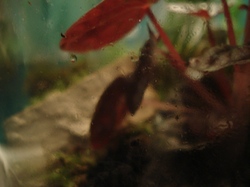 Typically, excess water is seen in the condensation that forms on the glass. Keep in mind, you want some condensation to form overnight. In the early morning hours, having glass with a bit of moisture is expected and desired. You know you have too much moisture when you see big droplets or the moisture lingers on the glass for hours into the daylight hours.
Typically, excess water is seen in the condensation that forms on the glass. Keep in mind, you want some condensation to form overnight. In the early morning hours, having glass with a bit of moisture is expected and desired. You know you have too much moisture when you see big droplets or the moisture lingers on the glass for hours into the daylight hours.
The good news is that this can be fairly easily fixed. Most folks recommend opening the terrarium for a few hours to let the condensation dissipate. Tried that, didn’t work that well. My approach? Open the terrarium and gently wipe some of the water off the under-side of the lid and the sides of the jar with a bit of bathroom tissue. I don’t aim for removing every bit of moisture. I try to go about 2/3 the way down to the dirt or so; leaving a bit of the moisture in place. So far, I’m finding that to be working fairly well for me.
Why toilet tissue? It is highly absorbent and easily crumbled into a small ball which makes it easier to slide between the glass and the plants without disturbing the plants. Just don’t let it get too wet or you will leave little bits behind on the glass.
Mistake #4 – Terrarium Placement
I’ve already mentioned putting a closed terrarium in direct sunlight is a mistake but don’t forget about the other heat sources in your home.
 Putting a terrarium on or near a radiator will lead to stewed plants. In tight quarters, you might put it near one of those sneaky heat sources if you’re not careful. Be mindful of the heat generated by refrigerators, computers and even light bulbs when you think about where you wish to display your terrarium.
Putting a terrarium on or near a radiator will lead to stewed plants. In tight quarters, you might put it near one of those sneaky heat sources if you’re not careful. Be mindful of the heat generated by refrigerators, computers and even light bulbs when you think about where you wish to display your terrarium.
Additionally, when placing your terrarium, you need to find a spot which provides a good amount of indirect light. All terrarium plants require light. Depending upon the natural light available in your home, you might have to provide supplemental light for the plants in your terrarium to thrive.
Terrarium Mistakes #5 – Fertilization
 Remember a parent, grandparent or other member of your family telling you to eat your veggies so that you will grow big and strong? Fertilizer is kinda like veggies for plants – it helps them grow big and strong. You generally don’t want terrarium plants to grow big and strong. You want that cute dwarf palm plant to stay small; you are growing a terrarium, not a towering tree. Simply put, fertilize your terrarium plants too much and they might grow out of house and home.
Remember a parent, grandparent or other member of your family telling you to eat your veggies so that you will grow big and strong? Fertilizer is kinda like veggies for plants – it helps them grow big and strong. You generally don’t want terrarium plants to grow big and strong. You want that cute dwarf palm plant to stay small; you are growing a terrarium, not a towering tree. Simply put, fertilize your terrarium plants too much and they might grow out of house and home.
One university website suggested waiting at least a year before even considering fertilizing your terrarium. They suggested using a 1/4 strength solution, only if the plants are yellowing and there is no other apparent reason for their decline.
Conclusions…
This isn’t meant to be a complete checklist of terrarium mistakes and advice on avoiding them. It is a list of things I learned to avoid when building my own terrarium and through a lot of research. Hopefully, you can avoid these and not have to learn the hard way like I did.
